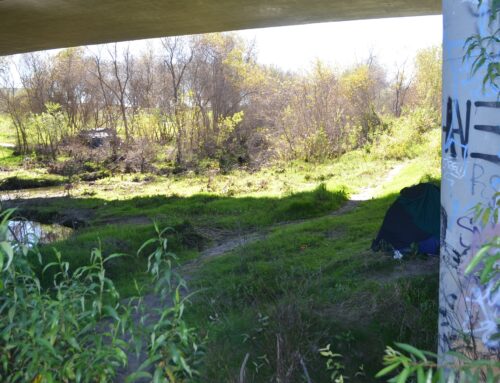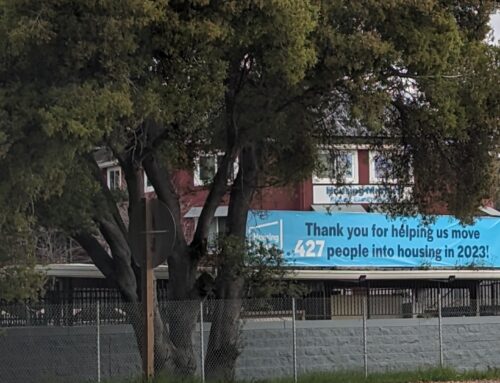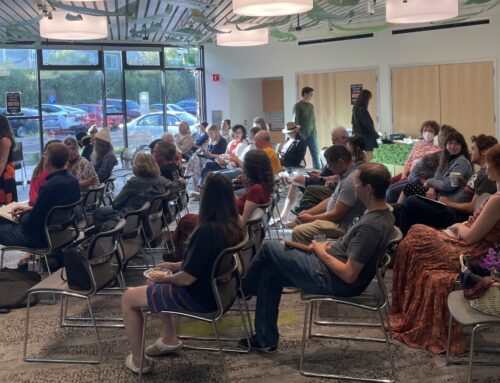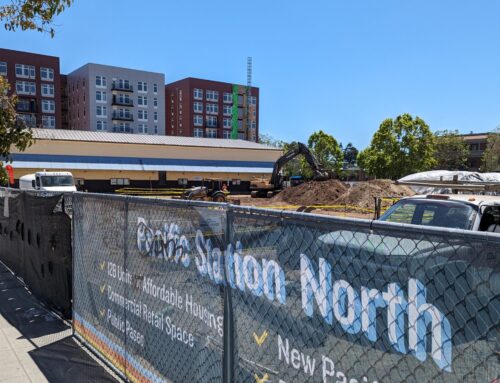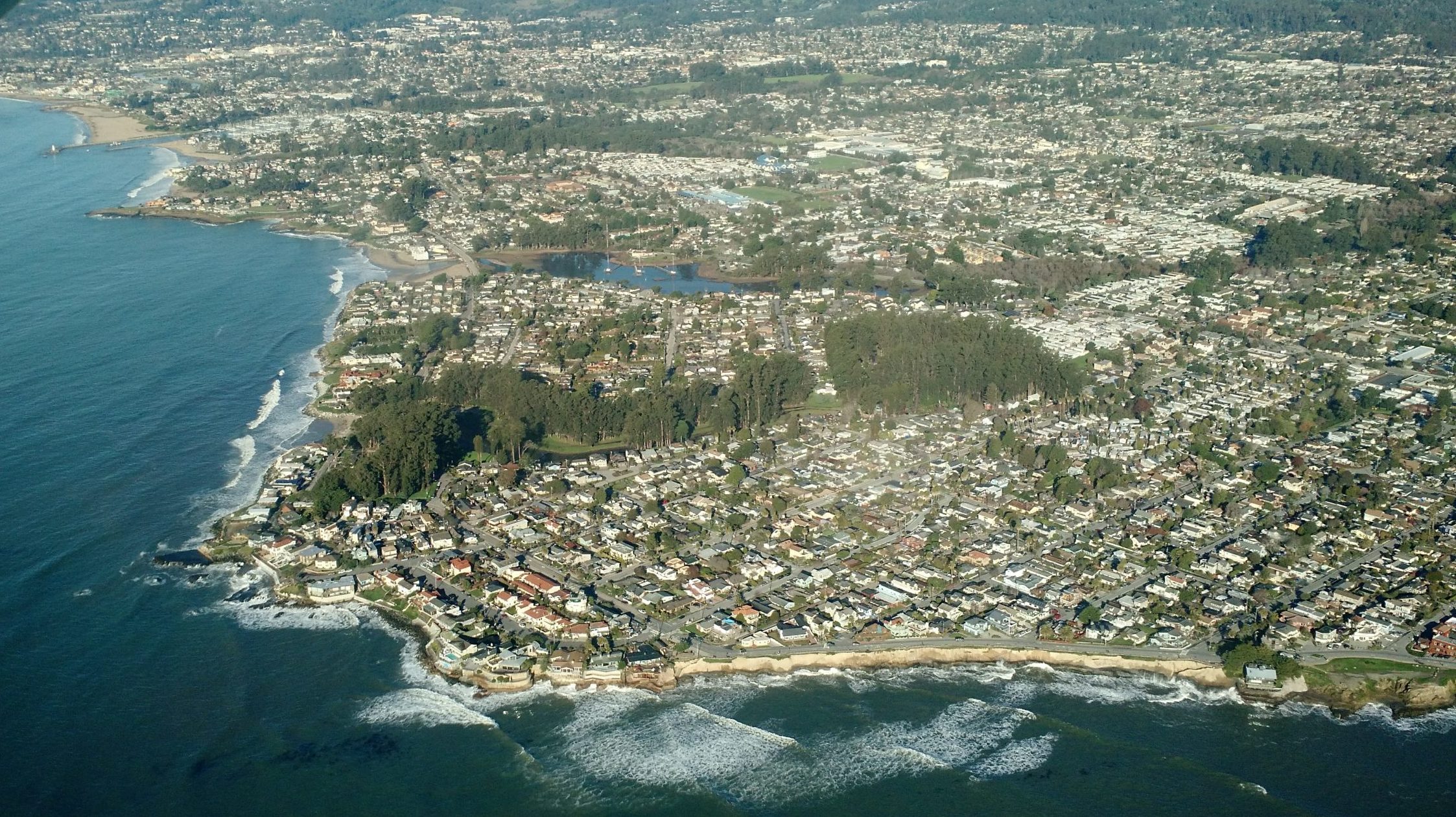
Local leaders recently released draft housing production goals for cities and areas in Santa Cruz County. (Kara Meyberg Guzman — Santa Cruz Local file, flight courtesy of LightHawk)
SANTA CRUZ >> The state’s requirements for the number of homes built in Santa Cruz County will more than quadruple if local leaders approve a draft plan released in April.
State leaders set home building minimums for each region to try to address the state’s housing shortage. The Regional Housing Needs Allocation (RHNA) goals are set for the Monterey Bay region about every eight years.
Santa Cruz County has had one of the most expensive housing markets in the world compared with median incomes. To try to catch up with housing demand and reduce residents’ housing costs across the state, state leaders have tried to boost housing production by setting more aggressive targets.
When areas do not make adequate progress on their housing production goals — which is common — state law allows streamlined approval of some housing projects. City and county leaders then have limited power to change projects under state law SB 35.
The Association of Monterey Bay Governments released the draft Regional Housing Needs Allocation plan in April. Local jurisdictions and the state Department of Housing Community Development have until June 6 to appeal the draft plan.
The draft goals for housing development from June 30, 2023 to Dec. 15, 2031 are outlined by jurisdiction.
Capitola
- 1,336 new homes are targeted to be built. More than half of the new homes would be required to be affordable for people with “low” or “very low” incomes. Income limits are set by the state. The new housing construction goal is more than nine times Capitola’s current goal.
- The current goal ーwhich the city has not met ー calls for Capitola to permit 143 new homes between Dec. 31, 2015 and Dec. 31, 2023. The city has permitted 53 homes in that period. Planners have issued one of 34 required permits for “very low income” units and zero of 23 required permits for “low income” units.
Watsonville
- 2,053 new homes are targeted, including 469 affordable units for people with “low” or “very low” incomes. That’s nearly three times Watsonville’s current goal, which the city has not met.
- Since Dec. 31, 2015, Watsonville has issued 302 of 700 permits required by the end of 2023. To meet the current goal, the city must permit 148 “very low income” units, 100 “low income” units, 113 “moderate income” units and 37 market-rate units by the end of 2023.
Scotts Valley
- 1,220 new homes are targeted, including 649 affordable homes for people with “low” or “very low” incomes. That goal is nearly nine times Scotts Valley’s current goal, which the city has not met.
- Since Dec. 31, 2015, Scotts Valley has issued 18 of 82 permits for “moderate,” “low” and “very low income” units required by the end of 2023. The city has exceeded the state’s goal for market-rate unit development.
City of Santa Cruz
- 3,736 new homes are targeted, including about 1,400 affordable homes for people with “low” or “very low” incomes. That goal is five times Santa Cruz’s current goal.
- The city must permit 123 of 180 required permits for “very low income” affordable units by Dec. 31, 2023 to meet its current RHNA goals. Santa Cruz has exceeded state development goals for market-rate and affordable units for other income categories.
Unincorporated areas of Santa Cruz County
- 4,634 new homes are targeted, including 1,492 affordable units for people with “very low” incomes. Unincorporated Santa Cruz County includes the San Lorenzo Valley, the North Coast, Live Oak, Aptos, La Selva Beach, Freedom and other areas. That goal is about three times the area’s current goal, which has not been met.
- The County of Santa Cruz must issue 335 permits for “very low” and “low income” units and 267 permits for market-rate units by the end of 2023 to meet the state’s goal.
Approval process and how to participate
The California Department of Housing and Community Development set the Monterey Bay region’s housing targets. The targets are based on estimated population growth and projections about vacancy rates, cost burden and households who live in crowded homes. The Association of Monterey Bay Governments, known as AMBAG, sets the targets for each local jurisdiction.
To submit comments on the draft plan by June 6, email Heather Adamson, the Director of Planning for the Association of Monterey Bay Area Governments, at [email protected] or mail comments to: Heather Adamson, AMBAG, 24580 Silver Cloud Court, Monterey, CA 93940.
AMBAG is the federally-designated planning organization for the Monterey Bay region. Local representatives on AMBAG’s board are: Capitola City Councilmember Kristen Petersen, Scotts Valley Mayor Derek Timm, Santa Cruz City Councilmember Justin Cummings, Watsonville City Councilmember Eduardo Montesino, and Santa Cruz County supervisors Manu Koenig and Greg Caput.
After the board approves the plan, each city and county in the region will be expected to submit a “housing element.” The housing element is part of each jurisdiction’s General Plan and is meant to ensure that local zoning allows the level of housing production called for by the state.
Response from local planners
Among Santa Cruz County jurisdictions, the City of Capitola has made some of the least progress toward the state housing production goals. Although the city’s housing element allowed zoning to match its projected housing needs, space constraints have limited development.
“It’s really tied to our available land for development,” said Katie Herlihy, the Community Development Director for the City of Capitola. “We’re just under two square miles, and we have less than a dozen vacant lots in the city, so any project really requires a property owner to reinvest into redeveloping their land.”
Capitola may face an even taller order for the next cycle. The city was tasked with zoning for 134 new units between 2015 and 2023. If the state’s new draft goals are approved, Capitola will need to zone for 1,336 new units by the end of 2031.
“We’ll have to look at our existing zoning and see if we can accommodate those additional 1,300 units,” Herlihy said. “If we can’t accomplish it, we’ll have to go through a zoning update and maybe even a General Plan update to show where we’re going to densify to meet those numbers.”
Watsonville has also made less progress than other jurisdictions in the county. At the end of 2021, the city had 302 of 700 housing permits required by the end of 2023. But Carlos Landaverry, housing manager for the City of Watsonville, said he believes the city will meet its RHNA goals for this cycle.
“We’re going to get there,” Landaverry said. “We have a lot of units in the works, so we feel very confident that we will meet those RHNA numbers by the end of 2023.”
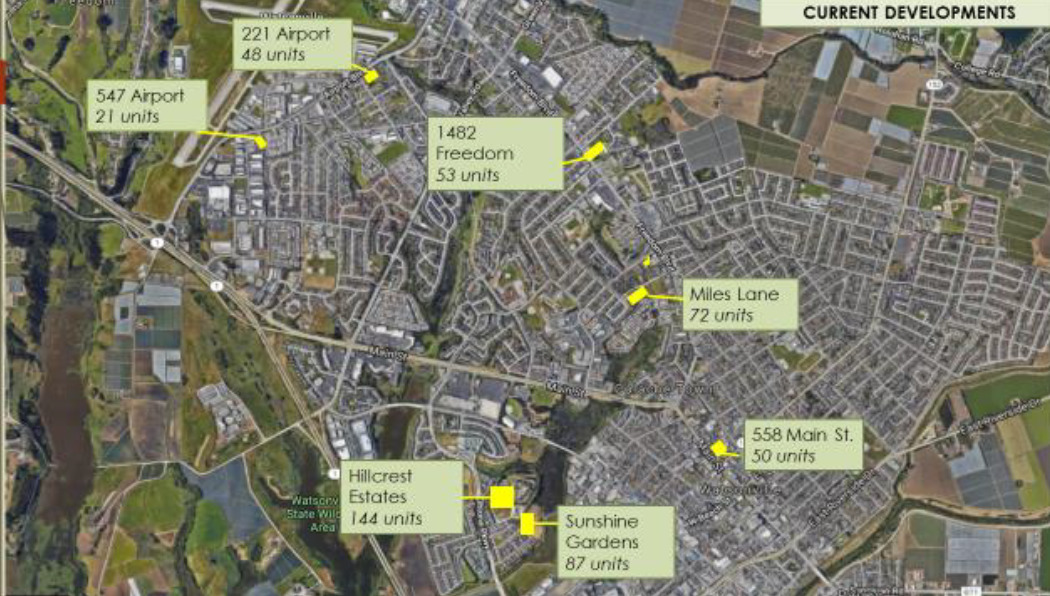
This map shows some of the housing projects in Watsonville that have been approved since 2015 but construction is not complete. (City of Watsonville)
The draft goals for 2031 will require Watsonville to plan for over 2,000 new units. The city’s Community Development Department is looking to densify Downtown Watsonville to accommodate many of those units, according to Landaverry.
“We’ll see how it goes,” Landaverry said. “We know that it’ll be a challenge.”
Progress on housing production goals
Santa Cruz, Watsonville, Scotts Valley, Capitola and unincorporated areas of Santa Cruz County have had mixed progress on their housing production goals through 2023.
Each year, local planning departments report progress on affordable housing production to the state. Scroll down to see data reported this spring by local governments to the California Department of Housing and Community Development.
Capitola
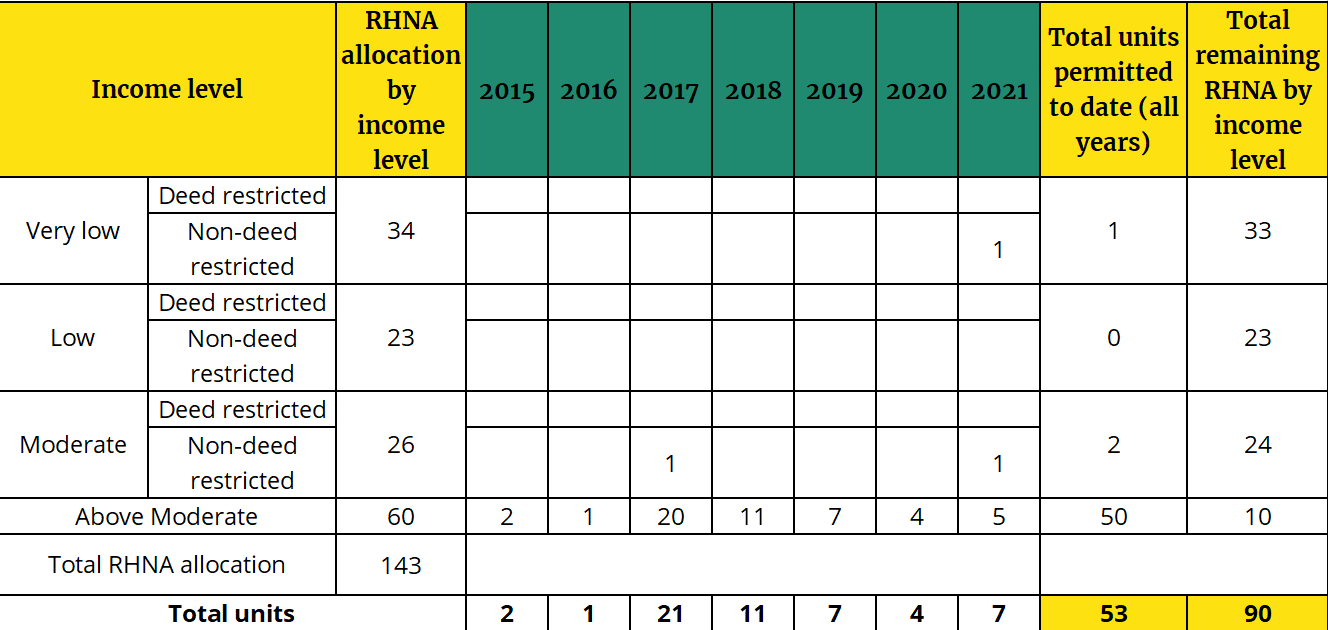
Source: 2021 Housing Element Annual Progress Report for the City of Capitola via email from Katie Herlihy | Graphic: Santa Cruz Local
Watsonville
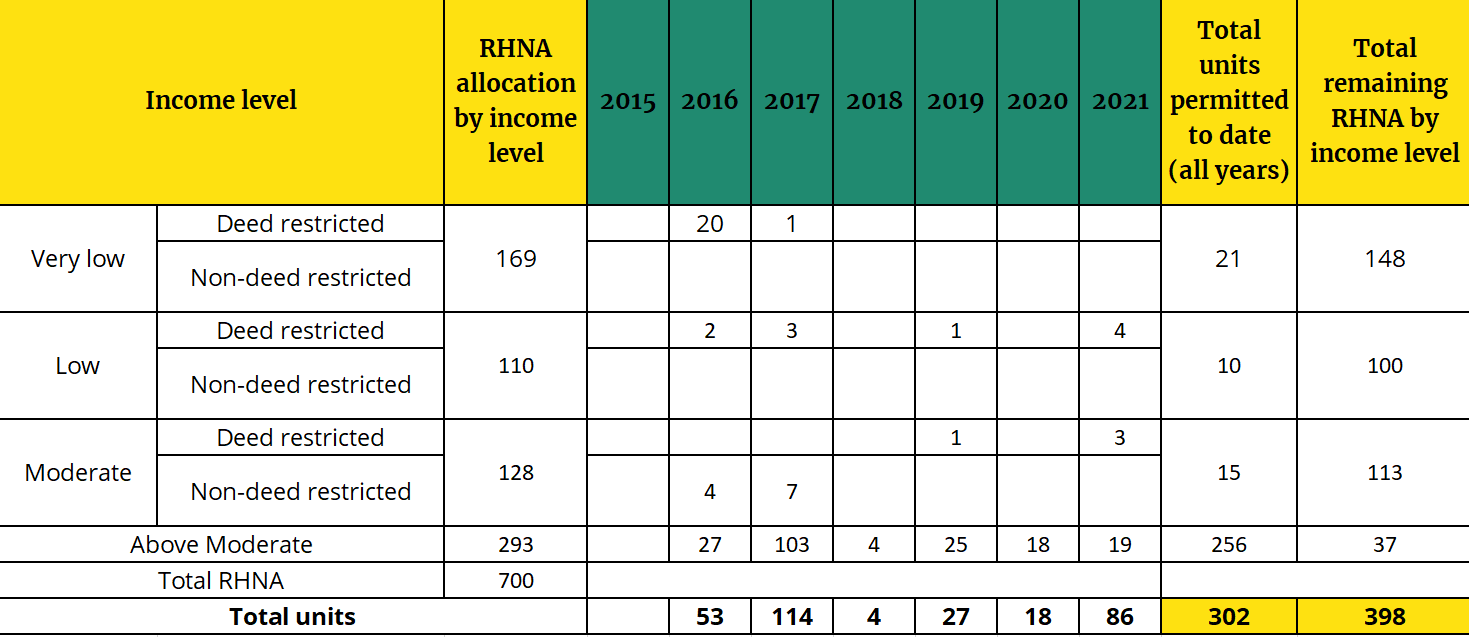
Source: 2021 Housing Element Annual Progress Report for the City of Watsonville | Graphic: Santa Cruz Local
Scotts Valley
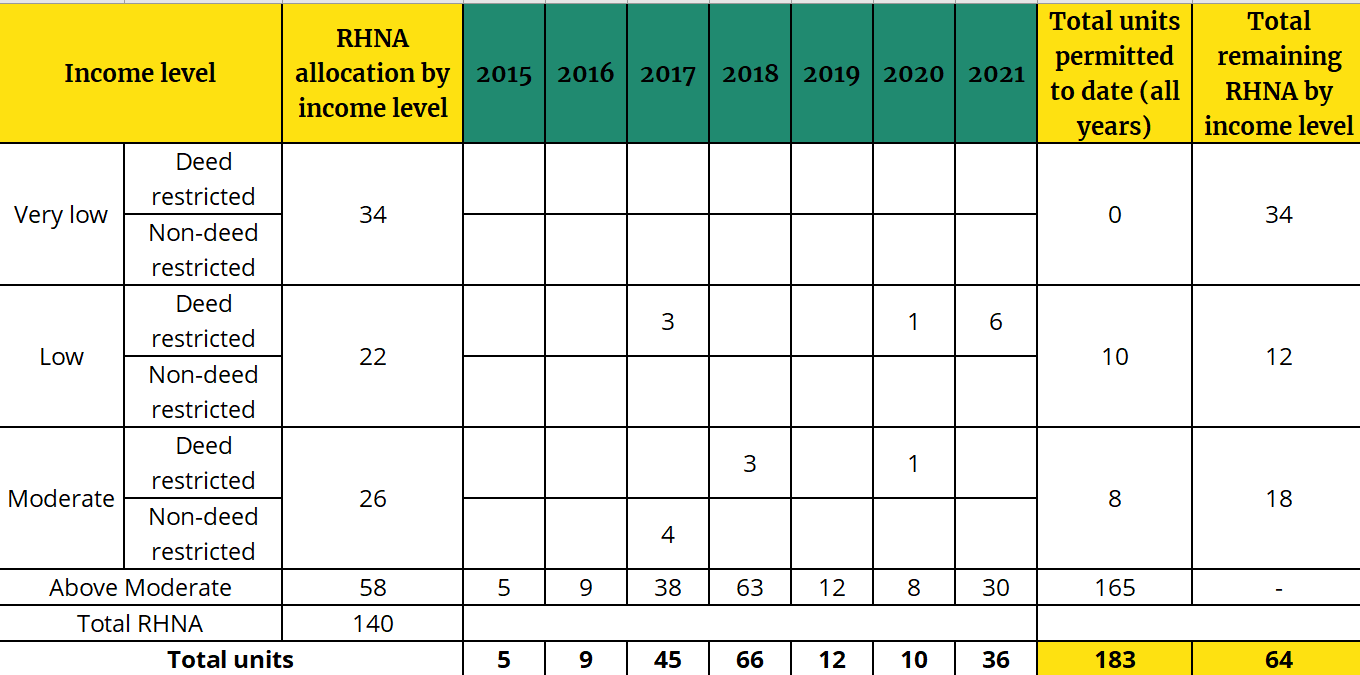
Source: Agenda report for March 16, 2022 City of Scotts Valley City Council meeting | Graphic: Santa Cruz Local
Santa Cruz
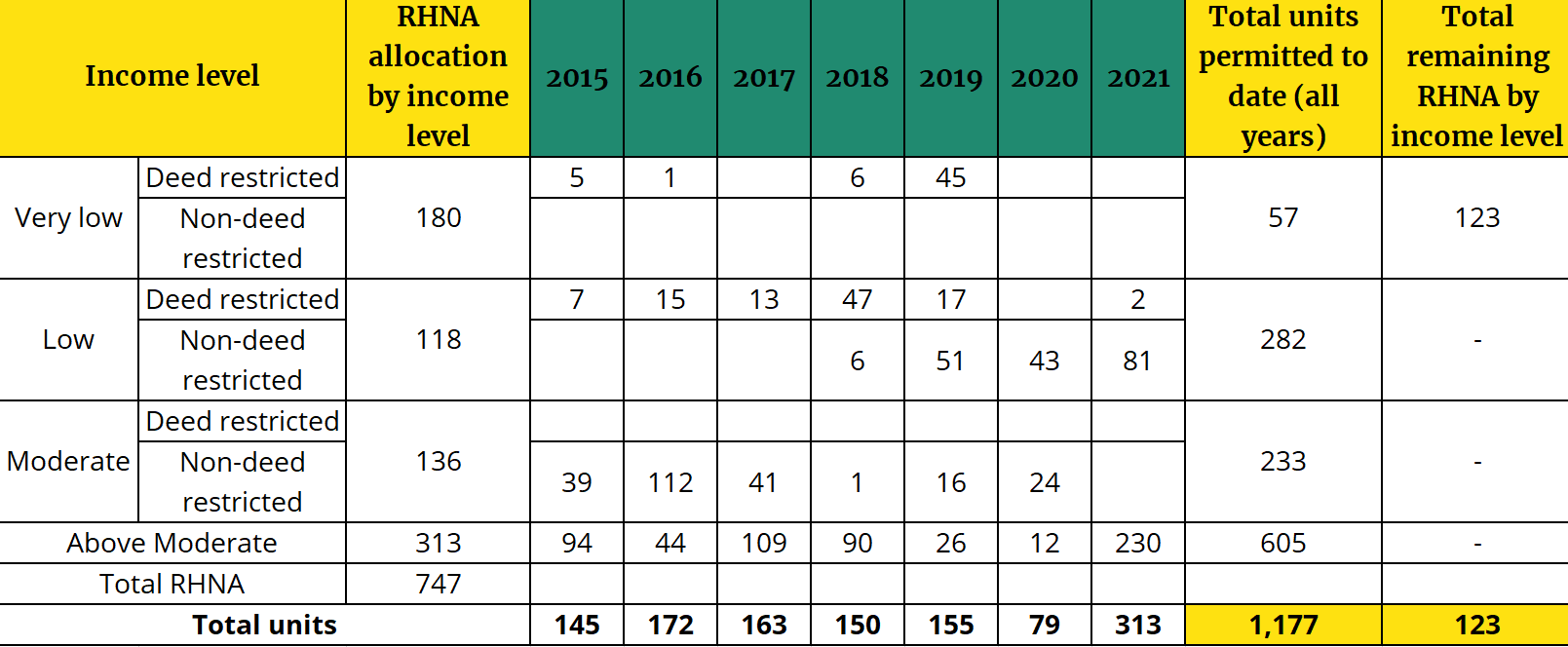
Source: Agenda report for March 10, 2022 Santa Cruz City Council meeting | Graphic: Santa Cruz Local
Unincorporated Santa Cruz County
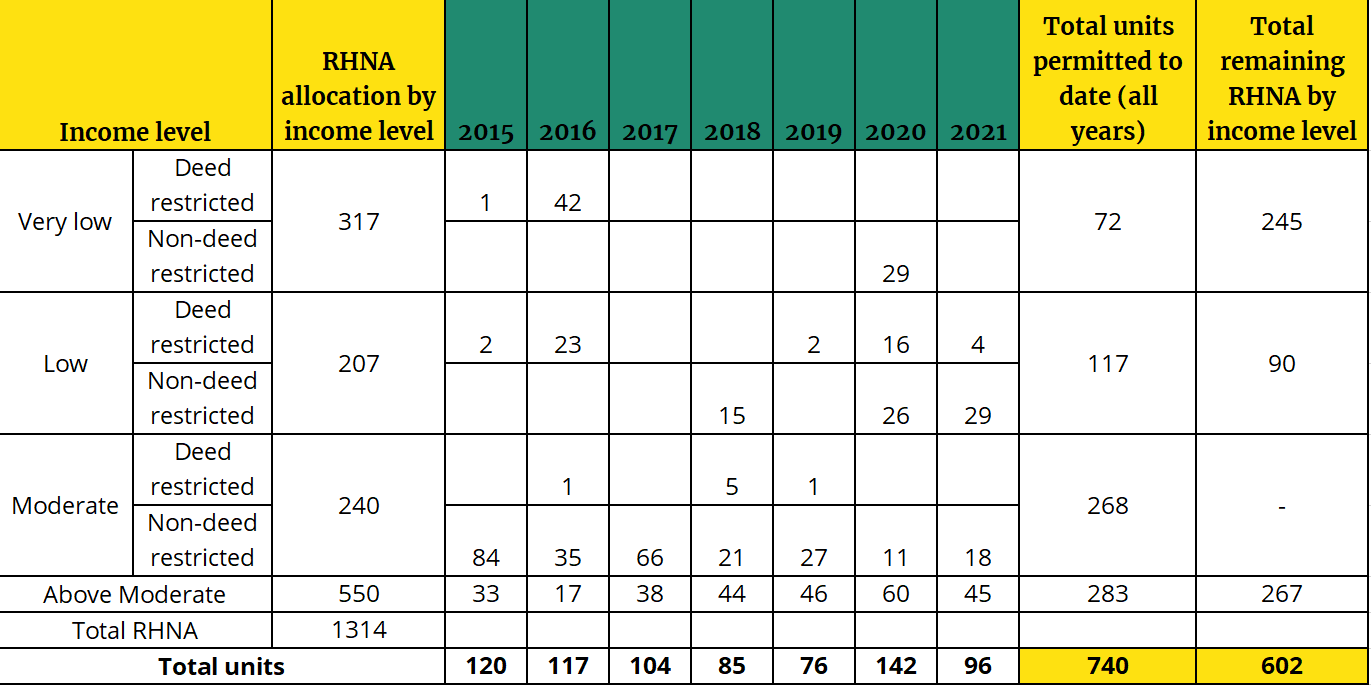
Source: Agenda report for March 9, 2022 County of Santa Cruz Planning Commission meeting | Graphic: Santa Cruz Local
Santa Cruz Local’s news is free. We believe that high-quality local news is crucial to democracy. We depend on locals like you to make a meaningful contribution so everyone can access our news. Learn about membership.
Graycen Wheeler is a freelance journalist and a master’s student in UC Santa Cruz’s science communication program. She lives in Santa Cruz.

